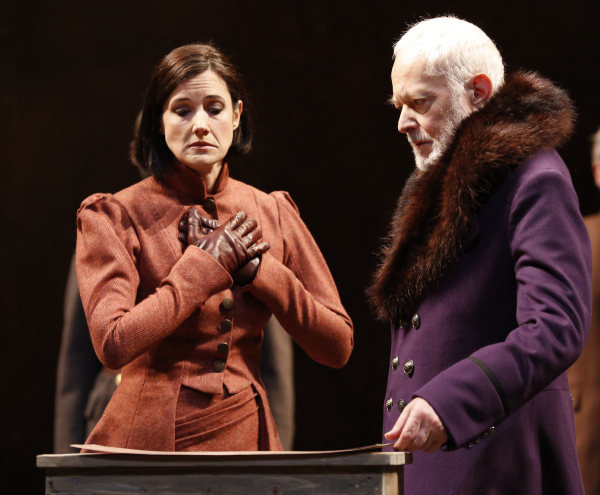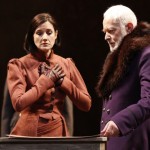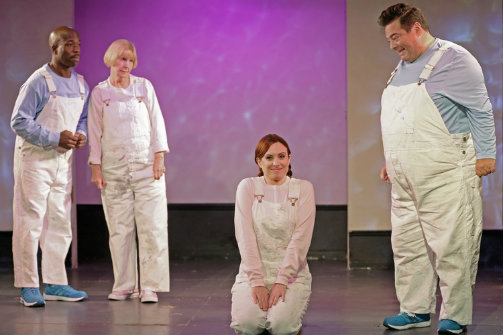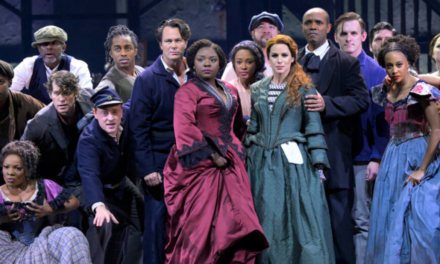By: JK Clarke
The joy of a year in which multiple productions of the same Shakespeare play are launched is that we get to see varied interpretations of the same material. It is the ultimate learning experience. Last year it was Macbeth: so many productions, so many different ways of looking at it. This year it’s looking like it may be King Lear that is oft repeated. So far there’s been the Frank Langella Lear at BAM (reviewed here in January); then John Lithgow will star in Shakespeare in the Park this summer; and NYU’s Skirball Center will stage it in the fall. The most recent is Arin Arbus’s production at Theater for a New Audience (TFNA) in Brooklyn. This King Lear has two unique attributes: first, this patriarchal (and usually male directed) play is being directed by a woman; second, it is a very thorough, lightly edited version, clocking in at nearly three hours. The latter is not, nor should be, a problem. King Lear is one of the more beautifully written and constructed of Shakespeare plays, wherein even the simplest, throwaway lines have a weight, significance and poetry of their own. “Sit you down father; rest you,” a mournful, anguished and caring Edgar says to his sightless father who had very recently been tricked into casting Edgar away and accusing him of conspiracy. But, with this simple line Edgar shows his tenderness and forgiveness for his father all at once.
Arbus’s Lear is a classic one. As the tragic King, Michael Pennington, despite his momentary lapse of sanity—in which he divides and gives away his kingdom and banishes his favorite daughter—is a fierce, strong, regal leader; one who is hoping to enjoy his retirement only to see he has made the most fatal and flawed decision of his entire reign. Lilly Englert, as Lear’s beloved yet banished daughter, plays Cordelia with just the right mix of stubborn resolve and gentleness. This is the central relationship of the play, and it is expertly designed and played.
There are other aspects of the cast that are interesting: Gloucester is played as doddering and foolish, despite his actual wisdom, almost like Hamlet’s Polonius; and, yet he has a vocal pattern not unlike Cary Grant’s, which, while unexpected, is not necessarily a detriment. And among the king’s attendant men, there is a very large, Baby Huey-like character (not directly identified in the program, unfortunately) who stands out among the others. His facial expressions and displays of grief at the King’s folly is heart rending and adds a dimension to the character of the soliders/king’s men not usually seen. One looks forward to seeing more of this actor in the future.
The play’s only low point comes in an early scene when the King and his men return to Goneril’s castle following the hunt. The (presumably) taxidermied beasts they bring on stage are too disturbingly life-like. A dead wolf is so realistic and so resembling a Husky dog that any compassionate dog owner would feel compelled to look away or perhaps even leave the theater. Apart from that, the costumes (Susan Hilferty) and set design (Riccardo Hernandez) are simply gorgeous, especially in unexpected use of the stage late in the play. Theater for the New City’s Polonsky Shakespeare Center also deserves special note: it is a fantastic, three-tiered space, a kind of modern take on the Globe theater with no bad seats and a promise of audience interaction with the play.
This King Lear is a wonderful production for those who thoroughly love the play and are excited to see it again, as well as to those who are seeing it for the first time. It is a straightforward interpretation of an already terrific play that will not fail to satisfy.
King Lear. Through May 4 at Theatre for a New Audience, Polonsky Shakespeare Center, 262 Ashland Place (between Lafayette Avenue and Fulton Street), Brooklyn.866-811-4111 www.tfna.org




















